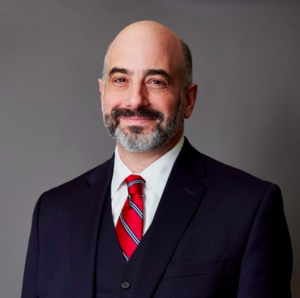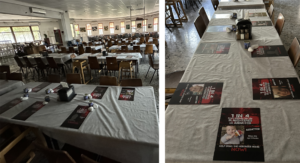By Doron Krakow

Kibbutz Nir Oz (Meadow of Strength) was founded in 1955, becoming part of the left-wing Zionist youth movement Hashomer Hatzair. In the hands of its roughly 70 founders, a formerly arid and bleak 5,000 or so acres of Israel’s frontier were gradually transformed into an idyllic setting, green and lush, and in time featuring more than 900 different types of trees, plants, and flowers in its renowned botanical gardens. Over the years, they harvested pomegranates, avocados, and asparagus. Colors have become its calling card, and perhaps 20 years ago the small kibbutz built a factory and became one of Israel’s major paint manufacturers.
Set along a portion of Israel’s southeast border with Gaza, Nir Oz has had to contend with episodic attacks, including rockets (for which there are fewer than 10 seconds’ warning); incendiary balloons; and other terrorist activity. A number of people have been injured and even killed, but the commitment to building a better life for their families, their community, and their country helped them to overcome. A friend who lives nearby once told me that life in this corner of Israel is 95% paradise, 5% nightmare—but the former makes it all worthwhile.
Nir Oz became a community of roughly 400—with members now part of four generations, children and grandchildren having chosen to remain and build their own lives and families there. The expanded community of Nir Oz also includes agricultural workers, largely from Thailand; students on gap-year programs; volunteers; and a seemingly endless stream of visitors and guests. That was the backdrop to the events that began shortly after dawn on October 7, amidst one of the most joyous celebrations of the year, the holiday of Simchat Torah, which began at sunset the evening before.
Earlier this week, I was hosted for a visit at Nir Oz. A friend had connected me with Ron Bahat, who was born there and who, together with his daughter, was visiting his parents in a section of the kibbutz that is home to a number of seniors, many of them founding members. Ron along with eight or 10 others I met are spending days doing what they can to attend to and maintain their now abandoned community. No one is permitted to be there overnight, so they come early in the morning, work throughout the day, and at night, go home to wherever they and their families are staying. They greeted me with warmth and gracious hospitality. Through the introductions I learned that several have family members in captivity in Gaza, while others are in mourning for the dead. That’s not right. They’re all in mourning for the dead. And all in anguish over the missing.
There had been a funeral on Friday, following identification of another couple who had been incinerated in their home. Forensic experts, having worked for weeks on such identifications, had managed to retrieve enough DNA from bone fragments to confirm who they were. Tal, z”l, and David, z”l, Shalo. Friday had been more than a month since their murder. More than a month. And this funeral will likely not be the last.
Ron took me on a tour of sorts. We walked through the homes of the people he grew up around. Each one, a personal reflection. This is Gadi and Miri’s house. This one belonged to Dina, who was in charge of landscaping. Orna lived here. She was among the first to see the terrorists when she went to the gan, the preschool, to begin preparing for the anticipated return of the children the following morning (after the end of the chag). Here is Chaim’s home. A hero of the Yom Kippur War, he suffered from a severe disability and lived with a caretaker. That’s the house of Yocheved Lifshitz, one of the two elderly women released from captivity in the first weeks of the war.
I found myself wondering how many of these homes he’d frequented on social occasions. How many of the yards did his children play in together with their friends? How many memories was he carrying of love and adventure, holiday celebrations, and family reunions? How had he and the other young men and women been received by family and by their community when they came home on leave from the army? How many weddings did they celebrate? How many births?
It was easy to imagine the life they’d lived. A glance in certain directions reveals what they all saw in the days before October 7. Manicured lawns. Sculptures. Children’s toys and bicycles. Exotic birds. I saw a flock of green parrots and a couple of regal peacocks. And the trees. The trees and flowers that at this time of the year seem like nature’s fireworks.
And then, that image was driven from my mind as I saw with my own eyes what remains of the carnage. In some places, the destruction was total. Houses burned to the ground with their occupants still inside. Small bits of the lives of the dead and missing are recognizable. The skeletal remains of a sewing machine. A Shabbat candlestick. A side table. Ron told me about one older man who, though he couldn’t read music, could play any song or composition on his piano by ear. Against a wall in his burned-out home, I noticed the remains of the soundboard, the part of the piano on which the strings produce the vibrations that bring its sounds to life. He didn’t survive.
Other homes had not been burned. In those, the scenes, left largely as they had been on that horrific day, told other parts of the story. Many had tried to barricade themselves in safe rooms. Built with secure doors and thick walls, these spaces were created to protect people from rockets or mortars. The designers never anticipated the rooms would be needed as protection from terrorists, so the doors have no locks. The only way to prevent them from gaining entry was to hold the handle and to do so with sufficient strength to keep the killers at bay. In some cases, for hours at a time. Many of the doors had bullet holes, the automatic weapons fire leaving pockmarks in the walls across the room. In one, the inside handle itself had been blown off by gunfire—a blood-spattered portion all that remains of the handle and its holder. What was left of another safe-room door had a gaping blasthole in it. The explosive force had been so great that an exterior wall of the house in the next room had been blown off its foundation.
Those people who were strong enough or creative enough survived. (In one home, the safe room occupants stacked books under the door handle, effectively jamming it shut.) Those who weren’t are dead or gone. Blood spatter and blood trails are all that’s left, along with broken furniture, children’s toys, and other items kept in these rooms, which as often as not are someone’s bedroom when there’s no reason to hide there.
One young couple visiting from the U.K. was staying in the home of cousins who were away for the chag. The bloody trail inside reveals that badly wounded, at least one of them made a desperate attempt to get away. They didn’t make it.
In another corner of the kibbutz, there is a U-shaped set of cabins where the Thai workers lived. They were rousted from their beds and herded into the small bomb shelter a few meters away, the place to which they would run to safety at the sound of the red alert, a regular feature of their lives on the Gaza border. There, they were slaughtered to the last, their blood coating the walls, ceiling, and floor.
In early August, the kibbutz completed a major renovation of its central dining hall and kitchens. Though no one had been inside during the attack, the terrorists made sure to destroy much of that as well. The kitchens were set ablaze. Behind the bullet holes that mark the doors and windows, the dining room has been reset. At each place, a name and a photograph of someone from the community. Of the roughly 400 people living there as the sun rose on that horrific morning, one out of four is gone. Dead or missing.
Those unaccounted for range in age from 9 months to 85 years old, though Kfir Bibas, who had been 9 months old when he was taken, is now well past 10 months, having spent an increasing portion of his life a captive of butchers. They are holding his 3-year-old brother, Ariel, and his parents, Shiri and Yarden, too. At least they were, as their abduction was captured on video by the terrorists and broadcast on social media—Yarden having suffered a grievous wound in the process.

Nir Oz’s dining room tables are full. Full of pictures and names. As I walked through, the silence in the room seemed to be broken by their screams and the screams of their families and of the members of the community left behind. Of course, those screams were in my head, but it didn’t make them any less shattering. I can still hear them…
Ron and I sat quietly in a makeshift office in a maintenance building at the end of our tour. He told me about his plans and those of others from this community to rebuild and renew their lives here. To focus on the younger families. To raise the quality and caliber of every program, every school, and every service. They see a future that is bigger, better, and stronger than before. In the depths of the darkness, somehow a light still shines.
The news cycle has largely moved on. Now, it’s about the fighting in Gaza. About Palestinian civilians compelled by Hamas to remain in harm’s way as Israel brings to justice the butchers of Nir Oz and so many other beautiful communities. It’s about the explosion of antisemitism around the world and the newfound fears of American and Canadian Jews. All that is real. But we cannot permit ourselves to forget Nir Oz. To forget what was done to its people. To our people. To us. We cannot forget. We will not forget.
Am Yisrael Chai.
*
Doron Krakow is President and CEO of the JCC Association of North America